Unlocking Higher SEO Mastery: Essential Tactics for 2025


SEO in 2025 is a battleground for online visibility. Over 91% of businesses report significant improvements in performance through effective SEO strategies. But here's the twist: it's not just about what you know—it's about how you implement it. Instead of the usual focus on keywords and links, the real game-changer is mastering content quality and technical finesse. This isn't just another trend; it's the foundation for sustainable success that will shape your digital landscape.
Table of Contents
- Core Higher Seo Tactics
- Mastering On-Page Seo Elements
- Content And Link Strategies
- Analyzing Seo Success Metrics
Quick Summary
| Takeaway | Explanation |
|---|---|
| Strategic Keyword Implementation is Essential | Focus on targeting long-tail keywords that align with user intent to enhance both search rankings and user experience. Place primary keywords in title tags and headings without engaging in keyword stuffing. |
| Content Quality and Structure are Critical | Develop high-quality content that answers audience questions, offers unique insights, and is well-structured for readability, as this is key for ranking higher in search engines. |
| Link Building Focuses on Quality Over Quantity | Build genuine relationships to earn high-quality backlinks through valuable content and guest postings, rather than relying on artificial link schemes for SEO success. |
| Regular Performance Analysis is Necessary | Track both success metrics (like organic traffic and conversion rates) and health metrics (like crawlability and page speed) to refine SEO strategies effectively. |
| Maintain On-Page Excellence Through Constant Updates | On-page SEO requires continuous improvement; regularly audit and update content and technical elements to adapt to new search engine algorithms. |
Core Higher SEO Tactics
Effective search engine optimization requires a strategic approach that combines proven techniques with evolving best practices. These core higher SEO tactics form the foundation of successful ranking strategies that can propel your website to the top of search results.
Strategic Keyword Implementation

The backbone of any successful SEO strategy starts with strategic keyword research and implementation. To rank higher on Google, you need to target the right keywords that align with user intent and your content offerings.
In 2025, precise keyword targeting has become increasingly important, with a special emphasis on long-tail keywords. According to Elastic, these longer, more specific phrases face less competition and attract highly engaged audiences who are looking for exactly what you offer. This approach enhances both user experience and search rankings simultaneously.
When implementing keywords:
- Place primary keywords in title tags and headings
- Include related terms naturally throughout content
- Avoid keyword stuffing that can trigger penalties
The key is creating content that serves the user's needs while naturally incorporating relevant terms. Search engines have become sophisticated at understanding context, so focus on comprehensive coverage of topics rather than exact keyword density.
Content Quality and Structure
High-quality content remains the single most important factor to rank higher in search engines. Google's algorithms continuously evolve to better identify content that provides genuine value to users.
To boost your SEO ranking, develop content that:
- Answers specific questions your audience is asking
- Provides comprehensive coverage of topics
- Offers unique insights or perspectives not found elsewhere
- Maintains readability with proper formatting and structure
One powerful tactic highlighted by Elastic involves creating dedicated, detailed pages for each product or service. This approach improves site navigation and user experience while signaling comprehensiveness to search engines. For example, educational institutions see higher rankings when they develop specific pages for each course or degree program rather than bundling everything together.
Technical SEO Fundamentals
Behind every high SEO ranking is a solid foundation of technical optimization. These elements ensure search engines can properly crawl, index, and understand your site.
Implementing HTTPS is no longer optional—it's a fundamental ranking factor. As noted by Elastic, secure sites receive preferential treatment in Google rankings while simultaneously increasing user trust and engagement. This security implementation represents one of the clearest examples of how user experience and ranking factors align.
Other critical technical elements include:
Site speed is paramount for both user experience and rankings. Pages that load in under three seconds perform significantly better in search results. Mobile optimization is equally essential, with Google's mobile-first indexing prioritizing sites that perform well on smartphones and tablets.
Structured data markup helps search engines understand your content and can result in rich snippets in search results, increasing click-through rates. Meanwhile, clean URL structures with relevant keywords make it easier for both users and search engines to understand page content.
Link Building and Authority
Quality backlinks remain crucial for establishing site authority and improving rankings. Modern link building focuses on earning high-quality links through valuable content rather than artificial link schemes.
Effective tactics include creating linkable assets (comprehensive guides, original research, or tools), building relationships with industry influencers, and guest posting on relevant, authoritative sites. Internal linking is equally important, establishing content hierarchies and helping search engines understand your site structure.
By implementing these core higher SEO tactics consistently, you'll build a foundation for sustainable ranking improvements. Remember that SEO is a long-term investment—focus on providing genuine value to users, and higher rankings will follow.
Mastering On-Page SEO Elements
On-page SEO elements are the aspects of your website that you have direct control over. Mastering these elements is crucial for achieving higher rankings in search engines. When properly optimized, these factors send clear signals to search engines about your content's relevance and value.
Title Tags and Meta Descriptions
Title tags remain one of the most powerful on-page ranking factors. According to Backlinko, Google's official documentation confirms that the "most basic signal" of content relevance is the explicit inclusion of search keywords within the title tag. This makes keyword optimization in titles a non-negotiable tactic even in 2025.
Your title tag should:
- Include your primary keyword near the beginning
- Stay under 60 characters to avoid truncation in search results
- Contain compelling language that encourages clicks
Meta descriptions don't directly impact rankings but significantly influence click-through rates. A well-crafted meta description acts as organic ad copy, enticing users to choose your result over competitors. While keeping it under 155-160 characters, focus on communicating value and including a clear call to action.
Content Optimization Strategies
Content remains king, but proper optimization ensures your content wears its crown effectively. Strategic keyword placement throughout your content is essential for ranking higher on Google.
The ideal approach to content optimization involves careful keyword placement in:
- H1, H2, and H3 headings (hierarchical structure)
- The first 100 words of your content
- Natural distribution throughout body paragraphs
- Image alt text and file names
Beyond keywords, content depth and comprehensiveness significantly impact rankings. Aim to create definitive resources that thoroughly address user questions and provide substantial value beyond what competitors offer.
URL Structure and Internal Linking
Clean, descriptive URLs contribute to both user experience and search visibility. An effective URL structure:
- Contains your target keyword
- Uses hyphens to separate words
- Remains concise and descriptive
- Avoids unnecessary parameters or numbers
Internal linking is often underutilized but serves multiple critical functions. A strategic internal linking approach helps:
- Distribute page authority throughout your website
- Establish content hierarchy and topic relationships
- Improve user navigation and engagement metrics
- Increase crawl efficiency for search engines
When implementing internal links, use descriptive anchor text that includes relevant keywords naturally. Prioritize linking to high-value pages you want to rank, and create a logical content structure that guides both users and search engines.
Schema Markup and Technical Elements
Schema markup (structured data) helps search engines understand your content's context and can generate rich snippets in search results. While not a direct ranking factor, schema markup increases visibility and can significantly improve click-through rates.
Common schema types include:
- Product reviews and ratings
- Event information
- Recipe details
- FAQ content
- Organization information
Other technical on-page elements requiring attention include image optimization (file size and alt text), mobile responsiveness, and page loading speed. These factors directly influence both user experience metrics and search rankings.
Maintaining On-Page Excellence
On-page SEO isn't a set-it-and-forget-it task. Search Influence emphasizes the importance of implementing a structured SEO roadmap with regular updates to content, meta elements, and technical on-page factors. This ongoing maintenance is essential for maintaining and improving search rankings amidst evolving algorithms and the rise of AI-driven features in search engines.
Regular content audits help identify opportunities to refresh outdated information, expand thin content, and realign with current search intent. As search algorithms grow more sophisticated in understanding user intent, your on-page optimization strategy must evolve beyond simple keyword placement toward comprehensive topic coverage and exceptional user experience.
By mastering these on-page SEO elements, you create a solid foundation for higher rankings in search engines. Remember that on-page optimization works best as part of a holistic SEO strategy that also incorporates quality backlinks and technical excellence.
Content And Link Strategies
Content creation and link building form the cornerstone of effective SEO. According to the 2025 State of SEO Survey by Conductor, 91% of respondents reported that SEO positively impacted their website performance and marketing goals in 2024. This reinforces the importance of developing robust content and link strategies to achieve higher SEO rankings.
Content That Drives Rankings
Creating content that ranks higher on Google requires a strategic approach that balances user needs with search engine requirements. In 2025, content strategies have evolved to focus more on depth and demonstration rather than mere information delivery.
Surfer SEO recommends focusing on long-form helpful content that thoroughly addresses user questions. This approach aligns with Google's helpful content update, which prioritizes content that provides comprehensive value to users. When developing content:- Start with thorough topic research that identifies user questions and search intent
- Create content clusters that cover topics from multiple angles
- Update existing content regularly to maintain relevance and accuracy
- Incorporate multimedia elements to enhance engagement
Demonstrating products within content has become particularly effective for higher rankings. Rather than simply describing features, show your solutions in action through case studies, tutorials, and practical examples. This approach helps users visualize how your offerings solve their specific problems.
Content formats that consistently perform well for SEO include:
- Comprehensive guides that cover topics exhaustively
- Comparison articles that help users make informed decisions
- Expert roundups that incorporate multiple perspectives
- Data-driven research that provides unique insights
Strategic Link Building
Link building remains a critical factor in achieving higher rankings, but the focus has shifted toward quality over quantity. Modern link building requires building genuine relationships and providing value to potential linking partners.
Surfer SEO notes that building links to blogs and key pages using strategies like guest blogging and contributing expert quotes can significantly improve SEO performance. These approaches work because they provide mutual value—you share expertise with another site while gaining authoritative backlinks.Effective link building strategies for 2025 include:
Resource link building involves creating exceptional content assets (tools, guides, research) that naturally attract backlinks. The key is developing something truly unique that serves as a reference point in your industry.
Digital PR has become increasingly important for earning high-quality links. By creating newsworthy content and building relationships with journalists and influencers, you can earn mentions from authoritative publications.
Skyscraper technique 2.0 focuses on identifying popular content in your niche, creating something substantially better, and reaching out to sites that linked to the original content. This approach works because you're offering a clear upgrade to something the site already found valuable.
Integrating Content and Link Strategies
The most successful SEO campaigns seamlessly integrate content creation and link building. Each piece of content should be developed with both user value and link potential in mind.
When planning content, ask:
- Will this provide unique value that makes it citation-worthy?
- Does it include original research, data, or perspectives?
- Can we incorporate expert insights that add authority?
- Does it fill a gap in the existing information landscape?
By answering these questions affirmatively, you create content that naturally attracts links while serving user needs. This integrated approach is more sustainable than treating content creation and link building as separate activities.
Measuring Content and Link Performance
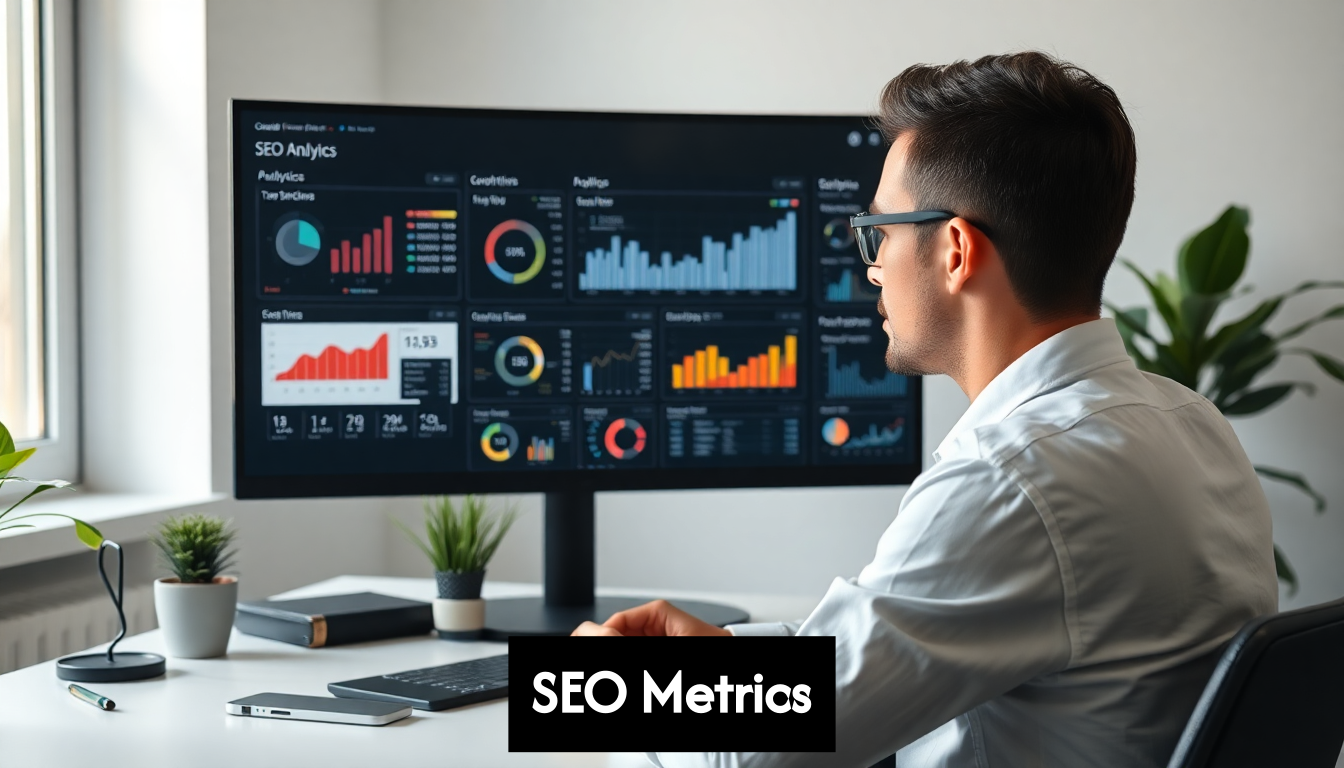
Regular analysis is essential for refining your content and link strategies. Key metrics to track include:
- Keyword rankings for target terms
- Organic traffic to specific content pieces
- Link acquisition rate and quality
- On-page engagement metrics (time on page, bounce rate)
- Conversion rates from organic traffic
By carefully monitoring these metrics, you can identify which content formats and link building tactics deliver the best results for your specific situation. This data-driven approach allows for continuous refinement of your strategy.
Implementing these content and link strategies consistently will gradually improve your search visibility and rankings. Remember that SEO success comes from persistent effort rather than quick fixes—focus on building sustainable assets that provide lasting value to both users and your business. With 91% of businesses reporting positive SEO impact, the investment in quality content and strategic link building is clearly worthwhile.
Analyzing SEO Success Metrics
Effective SEO requires not just implementation but careful measurement to understand what's working and what needs adjustment. Tracking the right metrics helps you demonstrate ROI, identify opportunities, and refine your strategy for higher rankings.
Success Metrics vs. Health Metrics
A critical first step in analyzing SEO performance is understanding the difference between success metrics and health metrics. According to UPCEA, success metrics measure outcomes and effectiveness of past efforts, while health metrics focus on technical aspects that enable future success.
Success metrics include:
- Organic traffic volume and quality
- Keyword visibility and rankings
- Conversion rates from organic traffic
- Revenue or lead generation from organic channels
Health metrics include:
- Crawlability (how easily search engines access your content)
- Indexation (what percentage of your site is in search indexes)
- Page load speed and Core Web Vitals
- Mobile-friendliness and technical SEO factors
By tracking both categories, you gain a comprehensive view of both your current performance and technical foundation. This distinction helps prevent the common mistake of focusing exclusively on rankings while neglecting the technical infrastructure necessary for sustainable success.
Primary Success Metrics to Track
A 2025 research report by Conductor found that 91% of surveyed organizations reported a direct positive impact of SEO on website performance and marketing goals. This substantial finding confirms the importance of monitoring and analyzing SEO metrics to justify resources and strategy.
When analyzing your SEO performance, focus on these primary success metrics:
-
Organic Traffic Growth: Track both overall organic sessions and segment by landing page, geographic location, and device type. Look for trends over time rather than day-to-day fluctuations.
-
Keyword Rankings: Monitor positions for your target keywords, with particular attention to movement in rankings for high-priority terms. Tools like Semrush, Ahrefs, or Moz can track hundreds or thousands of keywords automatically.
-
Click-Through Rate (CTR): Available in Google Search Console, CTR helps you understand how compelling your search listings are to users seeing your site in results.
-
Backlink Profile: Track both quantity and quality of backlinks, including the rate of new link acquisition and diversity of linking domains.
-
Engagement Metrics: Bounce rate, time on site, and pages per session help determine if your SEO traffic is actually engaging with your content.
According to Traffic Think Tank, these key performance indicators offer multidimensional insights into both visibility and business impact, which is essential for comprehensive SEO analysis in 2025.
Conversion and Business Metrics
While visibility metrics are important, connecting SEO to business outcomes provides the most compelling case for continued investment. Track these business-focused metrics:
- Conversion Rate by Landing Page: Identify which organically-ranking pages drive the most valuable user actions.
- Revenue from Organic Traffic: For e-commerce sites, track the direct revenue contribution from organic search.
- Cost Per Acquisition (CPA): Compare the cost of your SEO efforts against the value of conversions they generate.
- SEO ROI: Calculate the return on investment by comparing SEO costs to revenue or value generated.
These metrics transform SEO from a technical marketing activity into a measurable business investment, making it easier to secure resources and support from stakeholders.
Tools for Effective Analysis
Successful SEO analysis requires the right measurement tools. While specific tools evolve, these categories remain essential:
- Analytics Platforms: Google Analytics 4 provides core traffic and conversion data.
- Search Console Tools: Google Search Console offers keyword performance, indexation status, and technical insights.
- Rank Tracking Software: Dedicated tools that monitor positions across multiple search engines.
- Technical SEO Auditing: Tools that identify crawl errors, speed issues, and other technical problems.
- Competitive Analysis Tools: Solutions that compare your performance against competitors.
Reporting Frameworks for Different Audiences
Effective SEO reporting changes based on your audience. For executives, focus on business impact metrics and high-level trends rather than technical details. Highlight ROI, market share gains, and competitive advantages.
For marketing teams, provide more detailed performance data, including content effectiveness and channel comparisons. For SEO specialists, include technical health metrics, specific keyword movements, and granular performance data.
Regardless of audience, follow these reporting best practices:
- Establish clear baselines for comparison
- Include visualizations that highlight key trends
- Provide context for numbers (is this good or bad?)
- Connect data points to specific actions taken
By analyzing both success metrics and health metrics consistently, you'll develop a clear understanding of your SEO performance and identify the most impactful opportunities for improvement. This data-driven approach ensures your efforts to rank higher are focused on tactics that deliver measurable results.
Frequently Asked Questions
What are the essential SEO tactics for 2025?
Effective SEO tactics for 2025 include strategic keyword implementation, high-quality content creation, technical SEO fundamentals, and a focus on quality over quantity in link building. Regular performance analysis is also crucial for refining strategies.
How can I improve content quality for better SEO rankings?
To enhance content quality, ensure it answers specific user questions, provides unique insights, and is well-structured with proper formatting. Focusing on comprehensive topic coverage and ongoing updates will also improve SEO rankings.
What role does technical SEO play in ranking higher?
Technical SEO forms the foundation for high rankings by ensuring that search engines can crawl, index, and understand your site. Key elements include site speed, mobile optimization, secure HTTPS, and structured data markup, which collectively improve both user experience and search visibility.
How can I measure the success of my SEO efforts?
Success metrics to track include organic traffic volume, keyword rankings, and conversion rates from organic search. Combining these with health metrics such as crawlability and page speed gives you a comprehensive view of your SEO performance.
Elevate Your SEO Strategy with BabyLoveGrowth.ai
Are you ready to conquer the SEO battleground in 2025? With 91% of businesses reporting significant improvements through effective SEO, it's clear that mastering strategic keyword implementation and creating high-quality, optimized content is crucial for success. But we know that keeping pace with evolving techniques—like integrating technical SEO fundamentals and consistent performance analysis—can be overwhelming for many.
BabyLoveGrowth.ai is here to simplify your SEO journey! Our AI-driven platform offers a seamless three-step process:
- In-depth business and competition analysis
- Creation of a customized 30-day content plan
- Automatic generation of SEO-optimized articles.
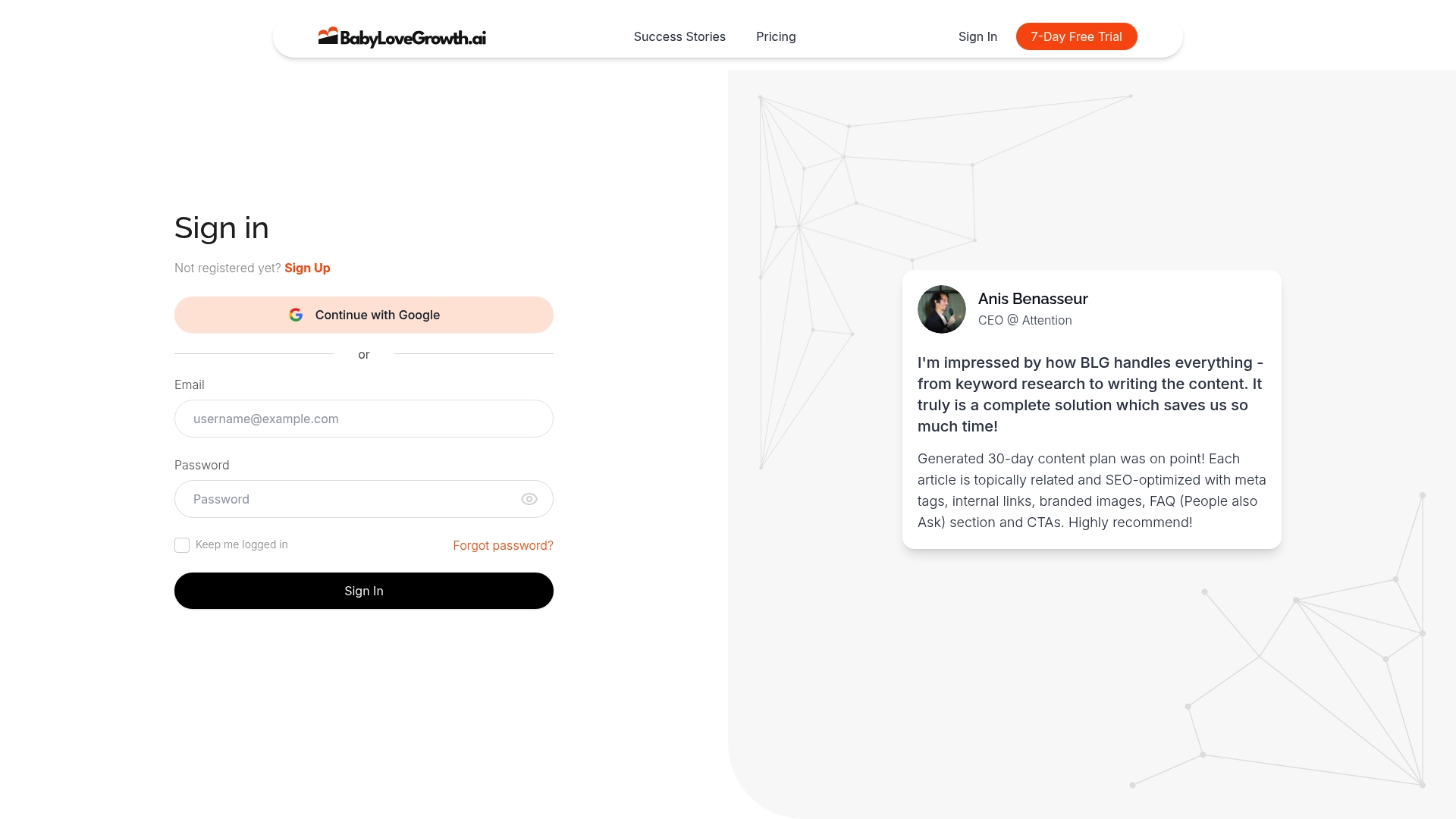
Imagine shifting your focus from the complexities of SEO to what you love most—growing your business! With our tailored solutions, you'll navigate the world's SEO challenges effortlessly, enhance your organic traffic, and leave your competitors in the dust.
Don’t wait! Start transforming your SEO strategy now by visiting BabyLoveGrowth.ai and claim your free trial today. Elevate your online presence as we handle the heavy lifting of content generation, empowering you to shine in this digital age!
Recommended Articles
Smart SEO,
Faster Growth!
Most Read Articles
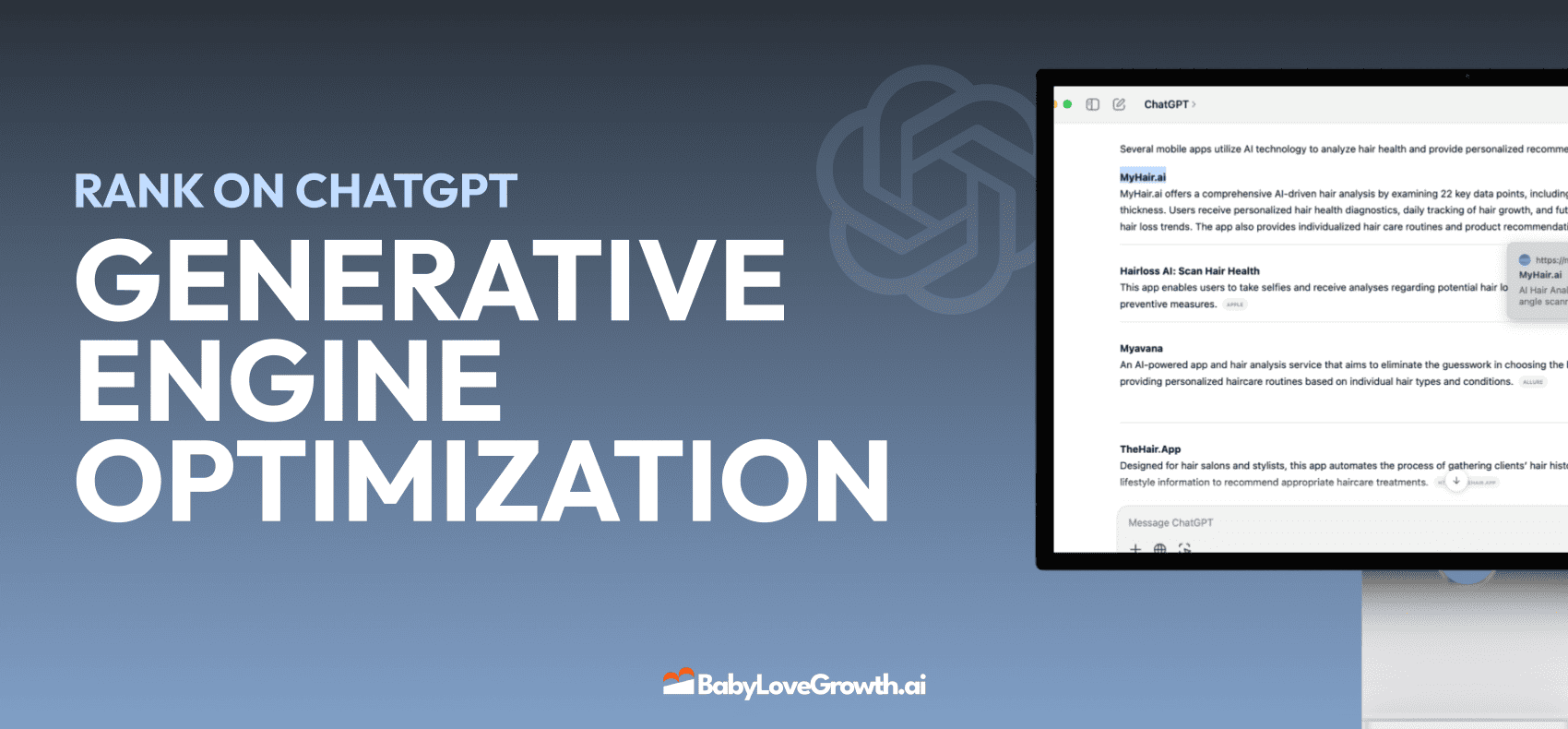
Generative Engine Optimization (GEO)
Learn how Generative Engine Optimization (GEO) helps your content rank in AI search engines like ChatGPT and Google AI. This comprehensive guide explains the differences between SEO and GEO, why it matters for your business, and practical steps to implement GEO strategies for better visibility in AI-generated responses.
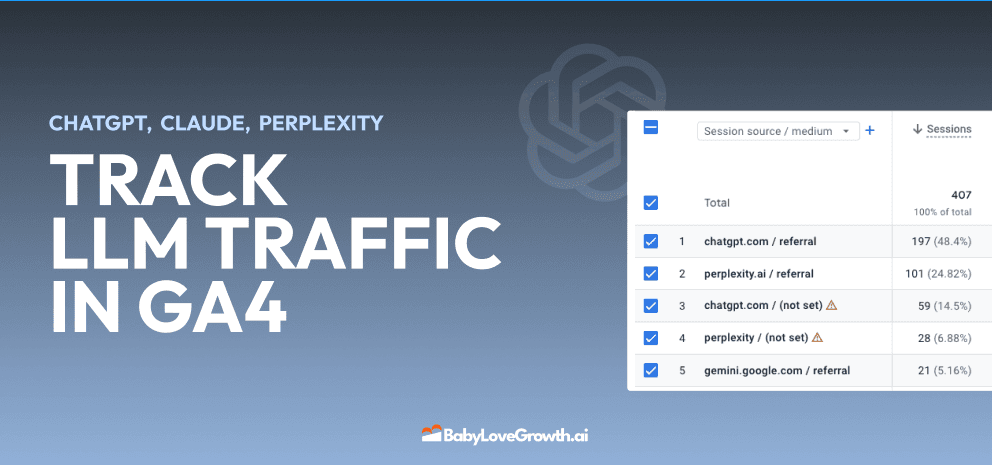
Track LLM Traffic in Google Analytics 4 (GA4)
Learn how to track and analyze traffic from AI sources like ChatGPT, Claude, Perplexity, and Google Gemini in Google Analytics 4. This step-by-step guide shows you how to set up custom filters to monitor AI-driven traffic and make data-driven decisions for your content strategy.
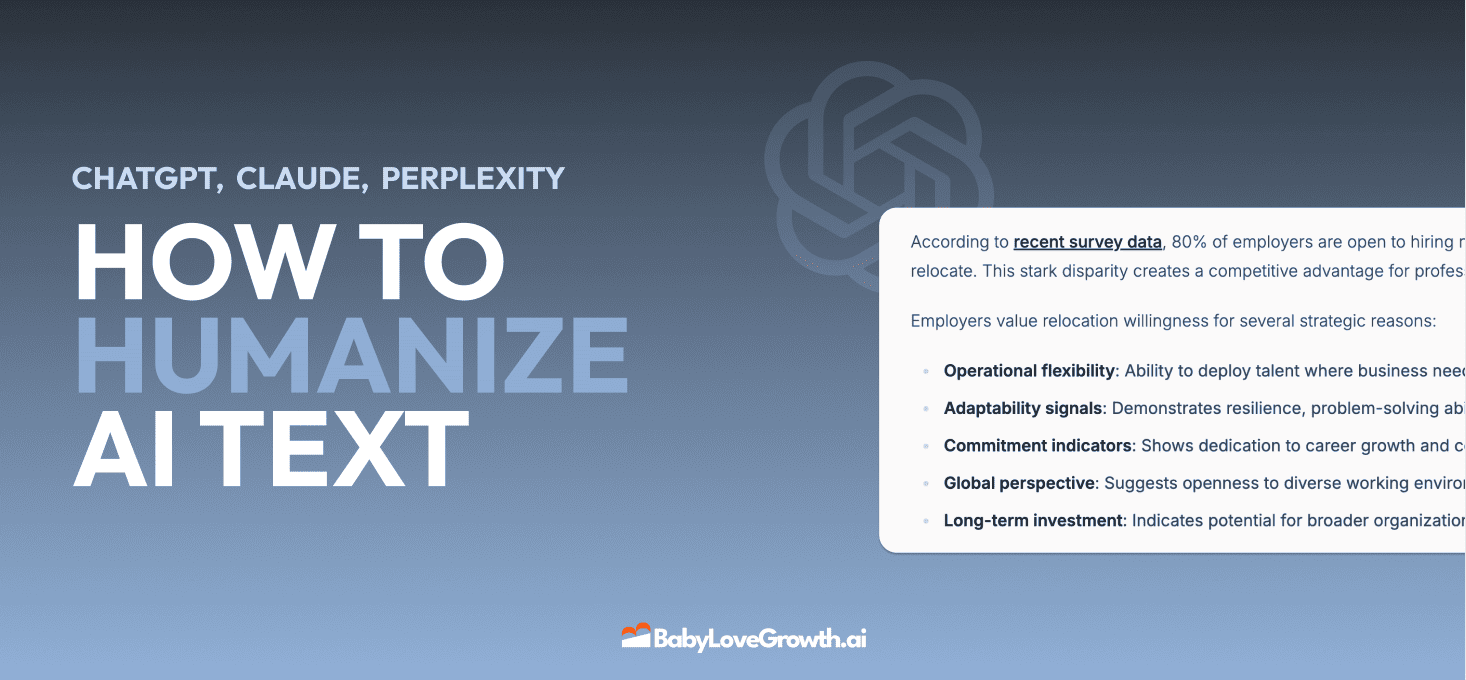
How to Humanize AI Text with Instructions
Learn practical techniques to make AI-generated content sound more natural and human. This guide covers active voice, direct addressing, concise writing, and other proven strategies to transform robotic text into engaging content.
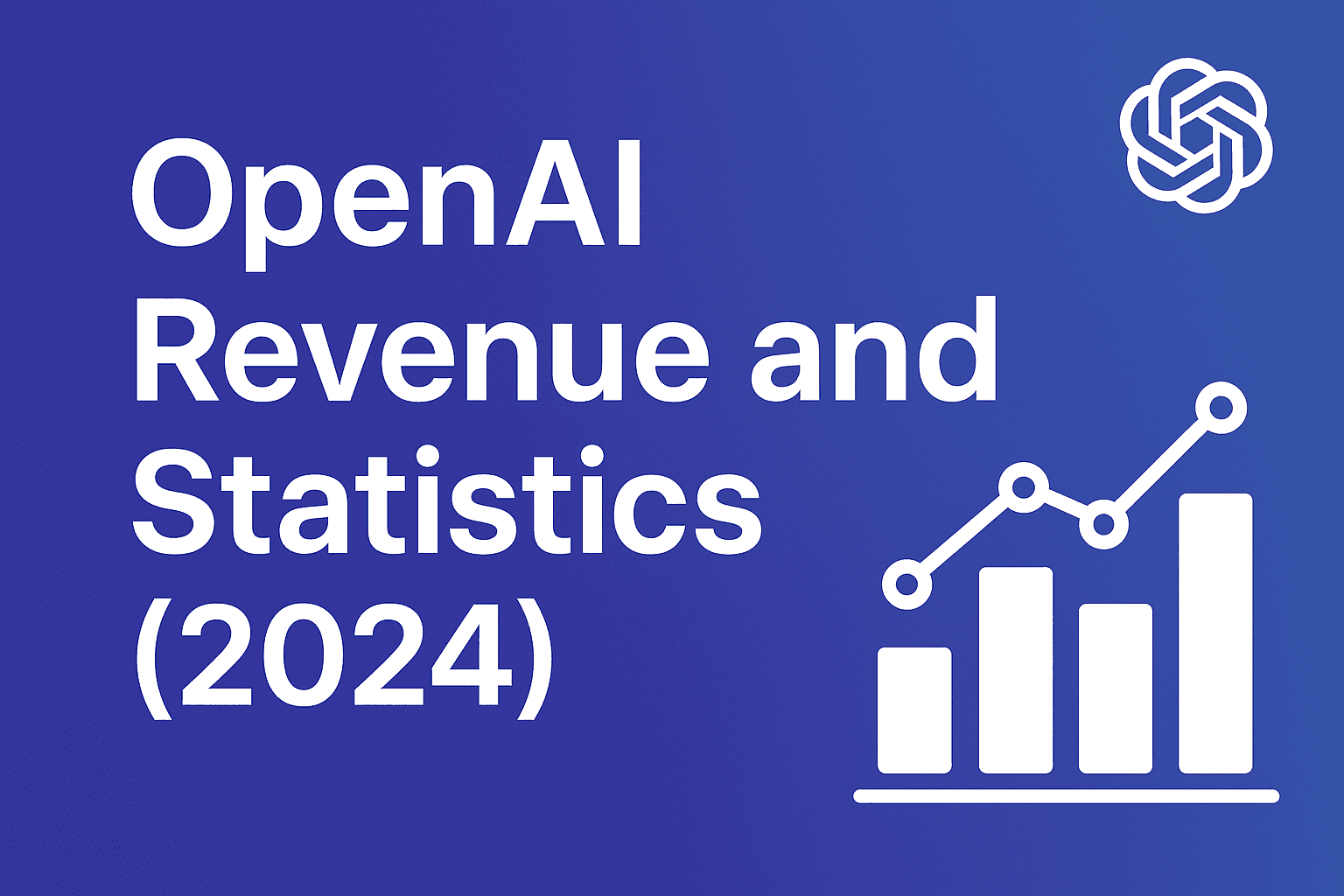
Open AI Revenue and Statistics (2024)
Comprehensive analysis of OpenAI financial performance, user engagement, and market position in 2023. Discover key statistics including $20B valuation, $1B projected revenue, and 100M+ monthly active users.